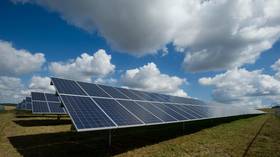Why India is the most exciting renewable market in the world

As India races towards its ambitious climate goals, it is quickly becoming one of the most exciting renewable energy markets on the planet.
While much of the world is seeing energy demand take a dive thanks to the economic and industrial slowdown spurred by the novel coronavirus pandemic, India has been making great strides to get more people connected to the grid than ever. Historically, much of the Indian subcontinent’s rural populations had no access to electricity, but the government has made electrifying all of India a major priority in the last year and a half. In order to supply the 1.353 billion who live in India (a conservative estimate that’s already two years old, by the way) with energy while still meeting New Delhi’s climate commitments, the country has set some extremely ambitious renewable energy targets. In 2015, as part of the Paris climate accord, India pledged that it would reach 350 Gigawatts (GW) of renewable energy capacity by just 2030, and far more recently, at the 2019 Climate Week in New York, India upped its ante to 450 GW over the next ten years.
While these targets are ambitious, to say the least, Sanjiv Nandan Sahai, Power Secretary for India, stated this week that his country is on track to meet its lofty renewable energy commitments. As of September 30, 2020, India’s renewable energy capacity clocked in at about 90 GW, primarily sourced from wind and solar (with wind accounting for 38 GW and solar accounting for 36 GW). Wind energy has been growing in India for twenty years now, while the nation has only been ramping up its solar capacity for half that time.
Also on rt.com Indian economy improving after coronavirus downturnThis means that, despite the Power Secretary’s optimistic assertions, India has a long way to go to meet its climate targets, and 2030 is just around the corner. In order to install the deficit 250 GW of renewable energy capacity by that deadline, India needs to install 25-35GW of renewable energy capacity every year, which is more than double the current rate.
“This would require concerted policy effort, including on the following: (1) demand creation for renewable energy; (2) revenue certainty for renewable energy power projects; (3) risk reduction for development, construction, and operation of these projects; and (4) system integration of variable and intermittent renewable energy supply,”reports Energyworld.com, a branch of India’s Economic Times.
For the world to have any hope of avoiding catastrophic climate change, it’s essential that the growing middle class around the world avoid the heavily polluting mistakes of the first world’s post-Industrial trajectory. This means that the twin giants of India and China, especially, carry a great burden for all of us to meet the growing energy demands of their combined population of nearly 3 billion people--more of whom are gaining access to electricity every day--with clean energy capacity.
READ MORE: Russia looking to bolster oil supplies to India for decades ahead
Luckily, the clean energy agenda can be one and the same as the energy security agenda for these rapidly developing nations. As we’ve seen in China, weaning the nation off of foreign fossil fuel exports has been a priority for the nation largely due to a desire for energy security and energy independence, but doing so has allowed the nation to keep setting and meeting loftier emissions goals while also creating a great public relations opportunity about Beijing’s contributions to the global clean energy transition.
India has also shown a twin incentive for ramping up its own installed renewable energy capacity, based in energy security as much as the need for a cleaner air and atmosphere, and it’s working: the nation is currently working on building the world’s single-biggest renewable energy project, a massive 30 GW solar–wind farm. “This park will be spread over 70,000 hectares of land, equivalent to Singapore and Bahrain,” Indian Prime Minister Narendra Modi said in a speech at the park’s kick-off last week. The new, almost impossibly large mega-farm will be located in Gujarat, India, where the enormous foundation for the project--and the world’s hope for avoiding climate change--has already been laid.
This article was originally published on Oilprice.com














